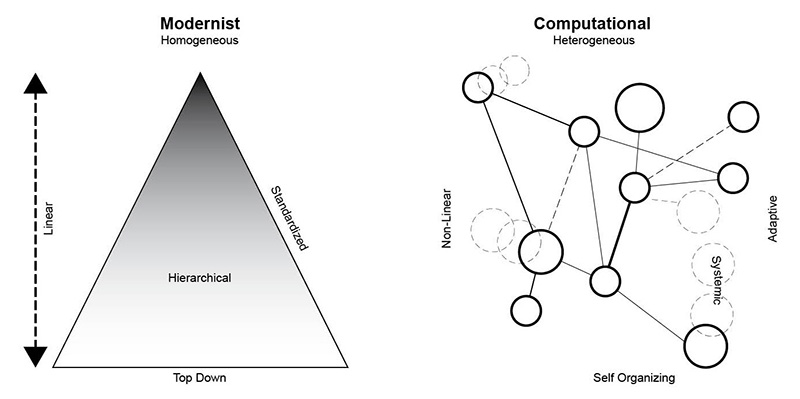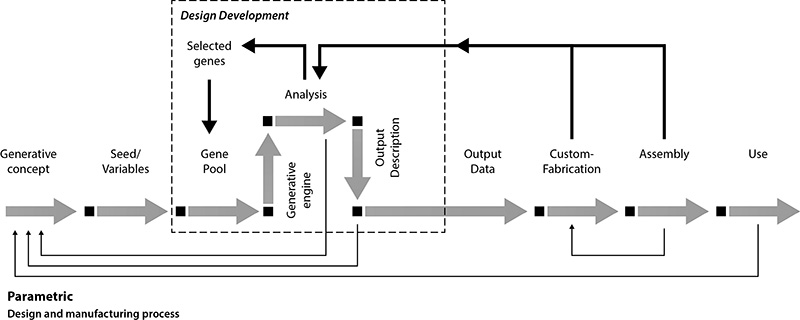Computational Architecture
What is Parametric Design?
Parametric Design is Systems Thinking
The time of Modernism has ended and the Bauhaus as an educational system is no longer relevant. The obsession of Modernists with the machine, linearity, homogeneity and hierarchies is being replaced with the tenets of Systems Thinking, self-organized systems, non-linearity, heterogeneity, and networks.
The underlying reason is the Industrial revolutions the word has experienced for the last 250 years. Starting with the 1st industrial revolution in 1765 with mechanization, followed by the mother of Modernism, the 2nd industrial revolution starting in 1870 with standardization and mass-production. Starting in 1947, the 3rd industrialization initiated a move from analogue technologies to digital technologies, and mass-customization, the mother of Systems Thinking.
While the new paradigm falls under the scientific philosophy of Systems Thinking, a confusing variety of axioms has developed around the concept within design disciplines: Parametric Design, Parametricism, Computational Design, Generative Design, Blobbism, Coding Culture, Digital Design, Systems Theory, Emergent Design or Algorithmic Architecture. These are principally talking about the same concept. While this can be confusing, it’s best to understand the interchangeability of these words under a . I’ll simply use Parametric Design here
Other descriptions sometimes mis-used are specific methods or tools within the discipline. Such as Building Information Modelling (BIM), Grasshopper, or Evolutionary and Optimisation design etc.
Firstly, we need to distinguish between Computation and Computerization. Computer Aided Design (CAD), a 2–3-dimensional form making using a computer is simply using the computer like a drawing board. It is not computation, but computerization. Entering data into a computer is a type of analogue work that essentially falls under a 1st industrialization thinking. Unlike computation that uses technology to process data through algorithms or protocols.
The 3rd Industrialization moved away from fixed hierarchical and linear systems to dynamic non-linear networks.
1st & 2nd Industrial revolution
- Hierarchical
- Linear
- Drive towards homogeneity
- Separation – specialization
- Repetition of the same
3rd Industrial revolution
- Network structures
- Non-linear
- Drive towards heterogeneity
- Integration towards specialization
- Self-organisation
While Modernism was the design formulation of the 1st and 2nd industrialization, Parametric design is the formulation of the 3rd and 4th industrialization. Much as early modernism, the new concept is still being formulated by the practitioners.
One major difference between the early Modernists and the early Parametricists is that the Modernists were late to the game, and in essence created a theory around the new material and manufacturing methods. In contrast, computational manufacturing and materials are being developed by and pushed forward by the parametric designers.
Parametric design requires a change in the idea of what a designer is. The myth of the Genius Architect is dead. The tale of that sketch or a “unique” idea on the back of an envelope that is then constructed to scale is a fantasy. The parametric designer does not know what the end result will look like, they guide the process in the role of a coder, whether analogue or digital, towards a final adaptive result
This is much like a process where water needs to be moved from one pond to another. The Modernist will carry the water in buckets from one to the other, the parametric designer will open the pond up, and guide the water with minimal efforts to the lower pond.
Coding is becoming increasingly important in all aspects of the developed world. This change is well established outside the design arena, with developed countries now teaching Coding in their K12 education. Estonia leads and teaches programming to 6 year olds. American universities teach coding to all students in the first year and the European Union is defining coding as a core learning objective. India will soon make coding mandatory in schools and coding is mandatory in schools in China.
Style versus Substance
Many designers consider computational design a style, with some naming this style one thing or the other while proclaiming themselves its high priest. Architectural styles have always emerged from the prevailing or contradicting cultural forces at a given time. Modernism was counter cultural, removing these cultural expressions and replacing them with second industrial ideas of “building and a machine” standardization and mass-production. Meaning that all buildings should look alike wherever they are in the world. The Gothic to Neo-Classicism were Western styles and Modernism was an international style. Modernism failed because it tried to fit society into modernism and not the other way around.
Computational Design is none of these things. It is based on processes, on the idea of interconnected networks and the emergence of things out of this process. A design form is created by the forces that work on if externally and internally. In architecture this means that it unavoidably becomes interconnected to it’s context. And every context is different, how can it therefore be an identifiable international style? Parametric Design might develop into a style as the concept develops, but it is not determined yet.
Another confusion is the mis-identification of various architects as “Parametric” purely based on the blobbyness or crumples of their international productions. However the similarities of these irrelevant of their locations around the world identifies them as sculptural Modernist in design and not Parametric.
Computational design is heterogeneous, and a part of its location. Here I do not mean a replication of the context, a form of standardization, but parametrically a part of its location.
Dynamic means process
The influence of Systems Thinking starts at the design process and this is what turns it into Parametric Design. While the traditional design was founded on fitting pre-determined forms to a given site, late Modernism included analysis and understanding of site and manufacturing:
In Simple terms each step in the process are factors that will influence the design. These get transformed by Systems Thinking where factor is a Parameter in the design process. Each parameter is made up of variables of different influence/power. Variables are dynamic making parameters dynamic too.
To take sunlight as an example. The location, time of day and time of year are all variables within the sunlight parameter. The importance and use of the sunlight parameter will change depending on location, e.g. Norway versus Dubai.
Each parameter is also influenced by other parameters in the system, Sunlight vs view, vs circulation etc.
It is worth stating that the design, manufacturing and functional process of any structure can be done parametrically, but using analogue methods. What the computer brings is processing power, able to iterate multiple options in a minute that would take a person days to complete.
Parametric design is a process. This process is adaptable, dynamic and evolving and potentially unidentifiable as style due to it’s heterogeneous nature.
By Gudjon Thor Erlendsson
© 2021 Gudjon Thor Erlendsson, all rights reserved.


